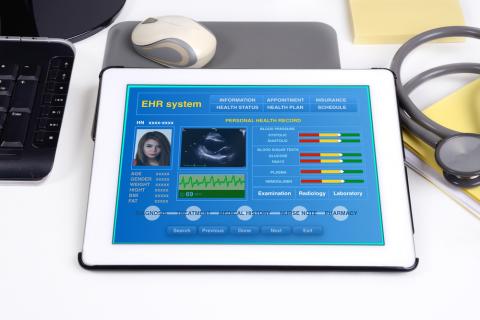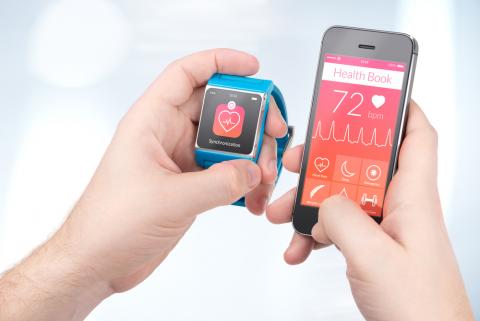Paperlight records such as electronic patient records offer benefits to patients, practitioners and services

What are electronic patient records?
Electronic patient records (EPRs), also known as electronic health records, are being introduced around the UK and physiotherapists need to be at the heart of this transformation. Digital programmes to deploy EPRs should be looking to change the way we work in healthcare, not simply to implement a paper-light or digital system.
Why are electronic patient records so important?
Embracing an EPR has many benefits for physiotherapists and can transform how we manage patients and service users:
Sharing data across the multidisciplinary team allows for informed clinical decision-making and goal-sharing.
Having shared information enables a more informed discussion with patients.
Information and data quality can be improved through standardisation of digital documentation and by using the EPR to reduce variation (Barry et al 2006).
The volume and detail of information stored means it will be possible to gather information about the health of populations. This will enable us to screen and categorise patients across a large area and guide relevant service improvements.
By using standardised data, we can also demonstrate the value of physiotherapy and highlight areas of good practice.
We know that physiotherapists will show an interest in electronic record-keeping if it leads to a positive return (Buyl and Nyssen 2009). Caution should be exercised, however, as the design of digital templates used by clinicians influences clinical reasoning and the quality of the record (Cochrane 2019).
It is therefore essential that physiotherapists are involved in the design, configuration and implementation of an EPR they intend to use. There is clear evidence that implementation is more successful if there is a subject-matter expert who can have a foot in both digital and clinical worlds.
Digital transformation can present challenges so think about options to reduce resistance to adoption:
Support should be provided to users who need additional help.
Consider quick assessment of digital literacy to help target training to those who need it most.
Remember staff and student inductions – to reinforce the message of a ‘digital is normal’ organisation.
Ensure adequate resourcing for training and ongoing support for staff and students.
Examples of electronic patient records
The Northern Ireland Electronic Care Record has transformed the availability of information and streamlined care. Smaller community systems in Northern Ireland include PARIS and LCID, used across multidisciplinary teams to relieve the reliance on paper and share information.
And the encompass programme is implementing a new digital system that will create a single health record for every citizen across Northern Ireland. In secondary, community and social care, all professions involved will have appropriate access to patient and service-user information. In this new paper-free system, all old systems and paper documentation will be replaced. This is the biggest transformation in healthcare Northern Ireland has seen.
Physiotherapists can get involved in the digital revolution by becoming digital champions. West Suffolk NHS Foundation Trust led the way in embedding a physiotherapist in its digital implementation team (Frontline article) and more trusts are following its example.
West Suffolk’s EPR is now in widespread use, with digital links to community services and local GPs, and the local tertiary centre at Cambridge allowing health information to be displayed across the various EPRs.
The ability to share the hospital record across trusts on different systems has been a game-changer in the way care is delivered, with information at the physiotherapist’s fingertips, regardless of where care is provided.
What should I do next?
Find out more about the clinical staff working in your digital teams. Most healthcare organisations have a chief clinical information officer and a chief nursing information officer who you could approach about becoming a digital champion.
To find out about encompass in Northern Ireland, contact your trust encompass programme manager.
Further information
Read the latest reports on digitisation of the NHS:
The Topol review – preparing the healthcare workforce to deliver the digital future.
The Wachter report – making IT work to improve care in England. This was the driver for the NHS Digital Academy and the Global Digital Exemplar programmes.
Imagine tomorrow morning...
You walk into work and sit down with your computer. A chime notifies you that your first patient is here. A chart automatically pops up with the patient’s previous history at the clinic clearly (and legibly) displayed.
The referral and recent X-ray have been preloaded into the chart. You take a history, perform an assessment and enter the information. The computer recognises the information you entered and proposes treatments, along with levels of evidence. An outcome measure is automatically generated and the patient fills this out while you prepare for treatment.
Relevant education materials are generated that you can link to the patient portal. After the treatment, you finish your documentation on the computer. A report or letter is automatically pre-populated with patient particulars, and you simply fine-tune it and send it electronically to the appropriate referrer or team member.
A new appointment can be generated that will not conflict with any other appointments the patient may have.
Elsewhere, researchers are using your anonymised outcome data from the patient to look at population health and build best-practice physiotherapy data.
A fantasy? Maybe for now, but this is the dream and the promise of electronic patient records.
Authors:
- Sarah Judge
- Angela Mooney
Edited by Daniel Allen

